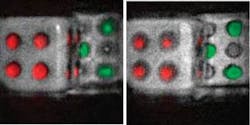Incoherent-light holograms are potentially useful in three-dimensional (3-D) outdoor and astronomical imaging, as well as fluorescence holographic microscopy. Although 3-D computed holograms have been created by taking multiple images of incoherently illuminated objects from multiple points of view, this process is slow and many images are needed. Another technique, scanning holography, uses a point detector to integrate the light intensity from Fresnel zone plates that are mechanically scanned over the object. Although the process produces a Fresnel hologram (obtained as a correlation between the object and the zone-plate patterns), it is also relatively slow.
Using a variation of Fresnel holography, researchers at the Johns Hopkins University Montgomery County Campus Integrated Imaging Center (Rockville, MD) have implemented a new and faster method of recording holograms. The method, called Fresnel incoherent correlation holography (FINCH), uses incoherent illumination.1, 2 Instead of using mechanical scanning or movement, the technique records on a CCD three sequential images of light reflected by a 3-D incoherently illuminated object that have propagated through a diffractive optical element (DOE). The three recorded holograms use a different phase factor of the DOE and are then superposed in the computer, resulting in a Fresnel hologram that reveals the physical features of the 3-D object.
In one experimental setup, a white-light arc lamp illuminates a 3-D object consisting of three white-on-black letters (O, S, and A), each with dimensions of 2 × 2 mm. The reflected light passes through a focusing lens and onto a DOE displayed on a spatial light modulator (SLM). The letters are positioned 24, 48, and 72 mm, respectively, from the rear focal point of the lens. The SLM operates in reflection mode, but could be used in transmission mode. In front of the lens, a filter passes a Poisson-like intensity spectrum between 574 and 725 nm with a peak at 599 nm and a bandwidth (full-width at half-maximum) of 60 nm. The three holograms, each with a different phase constant of the DOE (0°, 120°, and 240°), are recorded with a cooled CCD camera.
Treating the optical system as an incoherent interferometer, a series of mathematical calculations analyzes the system following its response to an input object of a single infinitesimal point. When the object’s point-spread function is known or estimated, the system operation for any general object can be realized. Analysis of a beam originating from a narrowband infinitesimal source can be completed using Fresnel diffraction theory.
Digitally reconstructed image
Three holograms of the same object are recorded at different phase constants; the final hologram is a superposition of the three individual holograms. The 3-D image is then reconstructed using a Fresnel propagation formula. As is expected from a holographic reconstruction of a volume object, any number of planes can be reconstructed. In one example, three different reconstruction planes are shown with a different letter in focus in each plane (see Fig 1).
In another example, blue light passing through a filter from a white-light arc-lamp source illuminates two dice, each 8 mm on a side with spots painted with red- and green-emitting fluorescent paint. The dice are positioned 228 and 260 mm from the lens. Three holograms are taken and multiple reconstruction planes imaged with a different die in focus in each plane (see Fig. 2).“The FINCH technique shows great promise in rapidly recording 3-D information in any scene, independent of illumination,” says researcher Joe Rosen.
The researchers hope the technique will facilitate a wide range of imaging applications, including holographic photography and fluorescence holographic microscopy. Their start-up company, CellOptic, is supporting its commercialization.
REFERENCES
1. J. Rosen and G. Brooker, Optics Lett. 32, 8 (April 15, 2007).
2. J. Rosen and G. Brooker, Optics Express 15, 5, (March 5, 2007).
About the Author

Gail Overton
Senior Editor (2004-2020)
Gail has more than 30 years of engineering, marketing, product management, and editorial experience in the photonics and optical communications industry. Before joining the staff at Laser Focus World in 2004, she held many product management and product marketing roles in the fiber-optics industry, most notably at Hughes (El Segundo, CA), GTE Labs (Waltham, MA), Corning (Corning, NY), Photon Kinetics (Beaverton, OR), and Newport Corporation (Irvine, CA). During her marketing career, Gail published articles in WDM Solutions and Sensors magazine and traveled internationally to conduct product and sales training. Gail received her BS degree in physics, with an emphasis in optics, from San Diego State University in San Diego, CA in May 1986.

